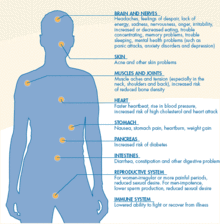Neurocardiology
[3] The constant communication between the heart and the brain have proved invaluable to the interdisciplinary fields of neurological and cardiac diseases.
Variations in the neural rhythms provide evidence that a problem is present regarding physiologic regulation and help physicians to more quickly determine the underlying condition based on the given symptoms.
In further detail, the heart receives its neural input through parasympathetic and sympathetic ganglia and the lateral grey column of the spinal cord.
The activation of the sympathetic nervous system contributes to endothelial dysfunction, hypertension, atherosclerosis, insulin resistance and increased incidence of arrhythmias.
When the brain perceives environmental danger, the amygdala fires a nerve impulse to the hypothalamus to initiate the body's fight-or-flight mode through the sympathetic nervous system.
This signals the release of cortisol, the stress hormone, initiating a multitude of physical effects on the body to aid in survival.
A negative feedback loop is then needed to return the body to its resting state by signaling the parasympathetic nervous system.
[7] An arrhythmia is defined as any disturbance in the cardiac activation sequence or any deviation from accepted limits for the rate or regularity of the normal impulse.
In a recent study on patients with already diseased hearts and electrocardiographic abnormalities, there was evidence of lost hypothalamic–medullary integration at the midbrain.
[7] A sudden epileptic death may be a result of the sympathetic activation or autonomic imbalance of the nervous system, as described earlier.
It is considered that both the spatial and temporal patterns of autonomic input to the heart play a key role in altered electrophysiological parameters.
Antidepressant medications have shown to be insufficient to induce the normalization of cardiovascular dysfunctions, which are associated with psychiatric conditions.
Exercise has a positive effect on the metabolism, which controls glucose levels, especially for stress-related pathology and brain disorders such as depression, which impose a heavy burden on the cardiovascular system.
Many studies are currently being conducted to gather more information regarding the common mediators of cardiovascular disease and the central nervous system.
